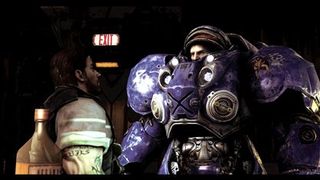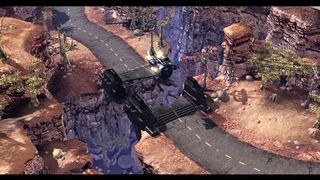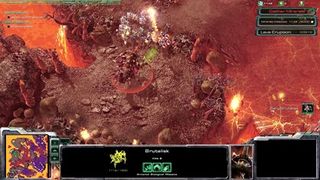Since the last time we saw StarCraft II, we’ve learned a little more: it’s to be delivered in three distinct packages, with Wings of Liberty focusing on Jim Raynor’s battle against the treacherous Mengsk, whose Dominion is establishing a classic propaganda-spewing dictatorship. It doesn’t feel like episodic gaming, though (which was so 2007) – it feels that Blizzard are just using their expansions more openly and sensibly.
Certainly, the pricing will reflect that – lead designer Dustin Browder has all-but confirmed the second and third games will be priced as expansions. And from a storytelling point of view, it makes sense: covering all three sides of the story in one package limits what you can do with each one. If each campaign were nine missions each, you’ve barely finished the tutorials before things are over. This way, you can spend 30 missions on the story of incorruptible lawman Jim Raynor, his personal redemption from his failure to protect lover Kerrigan from the Zerg, and the battle with the evil monster that she’s become.

Speaking of which, if you’re wondering about the impact you can have on the storyline, the answer is none – at least in the long-term. There’ll be a couple of moments when you have to decide one path or another, but they won’t affect the final outcome of the campaign, and won’t be referred to in later expansions. Blizzard are telling the story, not you, so drop that Fallout 3 attitude right now.
Eloquent motor mouth Browder spent 20 minutes guiding us around the game’s interface. If you’ve watched the Battle Reports on the StarCraft website, you’ll be familiar with his voice – upbeat, irresistible and gently exhausting. Rob Pardo is on his way, but as Blizzard’s vice-president he’s in charge of three huge in-development franchises, and another big secret project. We can probably forgive him being 10 minutes late.
When Pardo arrives, he has a chance to explain Blizzard’s position on casual and hardcore gaming: “It depends on your definition of casual player. We can use it to refer to ourselves, as the everygamer, or we can use it for people who play PopCap games. If you’re asking, are we going after moms who play Bejeweled, then no – that’s not the people who play StarCraft.”

Pardo defends his position as developing a game for the hardcore first, then making it accessible as simply good game-making. The idea isn’t to dumb the game down, but to let the player in. It’s not two discrete pools: the casual becomes hardcore. Fair enough, as the dead eyes of the Bejeweled mom are startlingly similar to those in the cocked, drooling head of a child who’s waiting for his 16th Satyr Horn to drop in Ashenvale.
He also has a chance to explain the late development of the single-player campaign – the StarCraft II team only started dealing with it halfway through the overall development cycle: “From an organisational point of view, it’d be great if we could start single and multiplayer development at the same time, but the reality is we have to figure out the units.
“We want to get the multiplayer up and running – then we start figuring out the units, what’s fun. How can you start designing a single-player campaign before you know what the units are? Start too early, and we’ll end up throwing out more missions than we already do.”

Other choice snippets include the defence of their decision not to support LAN – “LAN will be a great footnote in the history of PC gaming, just like DOS”; the rejection of Steam and Games For Windows – LIVE! in favour of Battle.net – “Why would we use those, when we’ve always had the best system in the world?”; and Blizzard’s reaction to the age-old PC piracy problem – “Our strategy has been to create a place where the players want to go. Of course you can pirate World of Warcraft – it’s just not much fun.”
